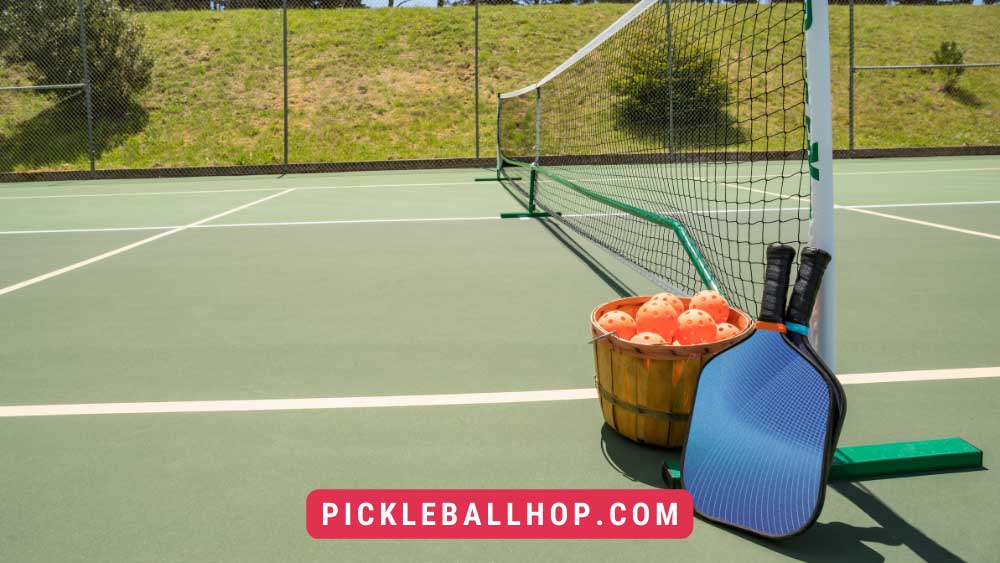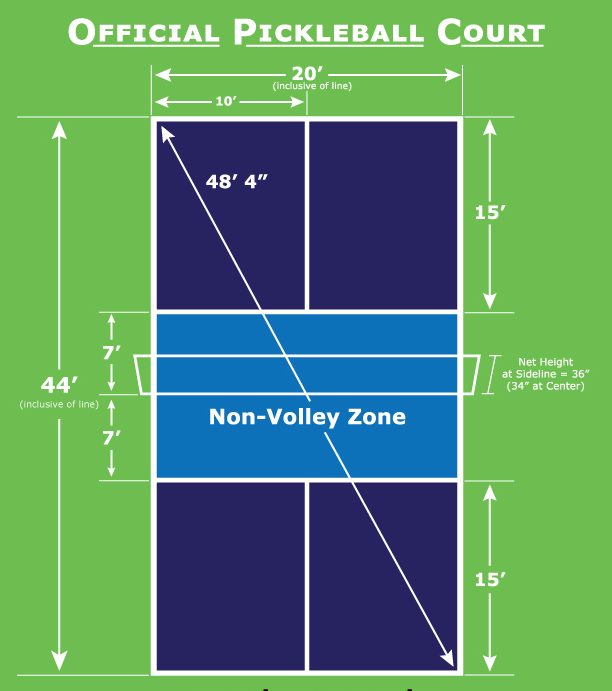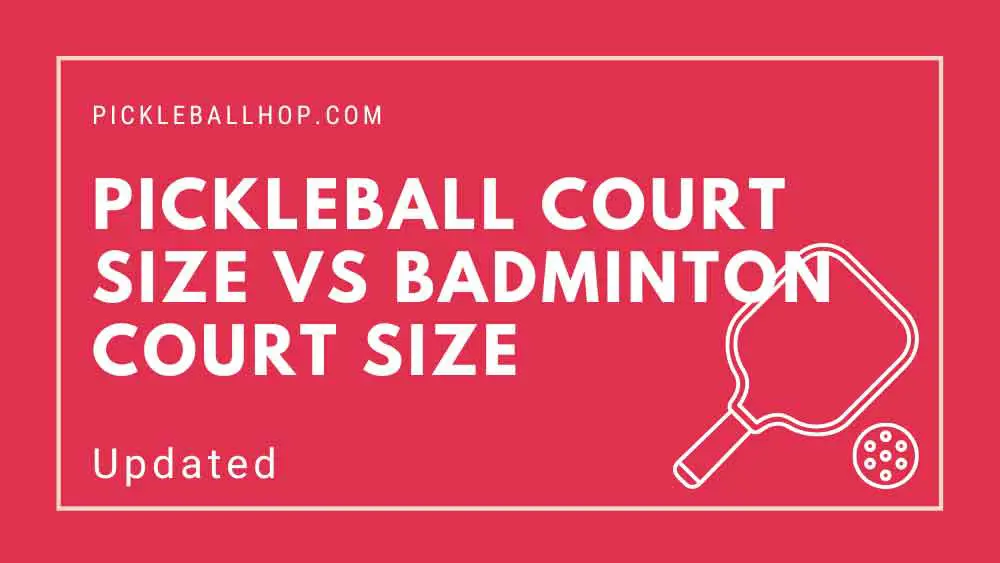If you’re considering how to build an outdoor pickleball court for your recreation center, school, or club, but you have no idea how to start, read on. Since pickleball courts are built virtually the same way as tennis courts, you’ve already won half the battle.
 This guide will help you understand the basics of constructing a pickleball court, whether you coach at a recreation center, a country club, a senior living community, or a school team. If you want to learn about indoor pickleball courts, you can read our guide here.
This guide will help you understand the basics of constructing a pickleball court, whether you coach at a recreation center, a country club, a senior living community, or a school team. If you want to learn about indoor pickleball courts, you can read our guide here.
#STEP 1: SELECT YOUR SPACE
How will the pickleball court be converted from a tennis or badminton court? Does the complex consist of multiple courts? Is the pickleball court being built from the ground up? The standard pickleball court size should be considered no matter what the situation, and then adjusted to suit the individual needs of the program.
You can easily divide a tennis court into four pickleball courts if you wish to play pickleball on it simultaneously, for example. A multi-court pickleball system would have roughly the same dimensions and construction as a single court. As a result, you will need to build multiple pickleball courts on a larger scale and will need to install fencing and padding between each of the courts.
- Pickleball Court Dimensions: 20 meters by 44 meters, for both singles and doubles play
- Pickleball Net Height: 36 inches at each sideline, 34 inches at the center
- Pickleball Playing Area: Converting a tennis court to a pickleball court is standard, but you should build a court that measures 34 x 64 if you intend to use it as a standalone pickleball court.
Diagram of official pickleball court dimensions
#STEP 2: Select the court surface materials
It is important to choose the right surface for your pickleball court whether you are building it from scratch or revamping an existing one. Among the common surfaces for pickleball courts are:
- Concrete: Among outdoor court surfaces, this type is both durable and cost-efficient.
- Asphalt: If you’re looking for a more affordable option, this can be a good choice. However, it may require more maintenance.
- Snap-Together Plastic: This surface can be applied on top of asphalt or concrete if you do not want to permanently change the surface of a multi-use court.
#STEP 3: Choose perimeter fencing
Pickleball multi-courts require fencing to contain the ball within the playing area and to provide security both for the players and spectators. In pickleball courts, there are a variety of different types of fencing, but the most common is the wire fence, which allows for both players and spectators to see into the court. These fences are also designed to let light into the court. An experienced pickleball court builder can assist you with picking and installing pickleball fencing. To prevent players from getting injured, make sure the surface is covered with rust-resistant materials.
Pickleball Fencing Dimensions: If the top of the fence is padded, a height of 10-feet is ideal, but a height of 4-feet can also work.
#STEP 4: SET UP LIGHT ON YOUR COURT
There is a fairly standard protocol for lighting pickleball courts. Light poles should be installed on all pickleball courts. At least 24 inches should be left between the poles and the court. These poles should be 18 to 20 feet high and placed at the center.
#STEP 5: BUY PICKLEBALL NET SYSTEMS
 It is logical to reach out to an expert to find a pickleball net system that best fits your space, surface, and court materials. Choose from a variety of pickleball poles and systems, each with its own characteristics.
It is logical to reach out to an expert to find a pickleball net system that best fits your space, surface, and court materials. Choose from a variety of pickleball poles and systems, each with its own characteristics.
Pickleball poles made for outdoor use are specially designed to withstand the elements since they are used outdoors for long periods of time. Generally speaking, the following components make up an outdoor pickleball system:
- Two poles
- One ratchet
- One outdoor pickleball net
- Sleeves (may or may not be necessary).
#STEP 6: Prepare your pickleball court
As soon as the pickleball court, fence, lighting, and other materials are chosen, they need to be constructed. Here are some suggestions to get you started:
- Hire a professional contractor. Even though installing a pickleball net system for a single court in your backyard might not seem that complicated, hiring a professional contractor can ensure the court is constructed correctly for recreation centers, clubs, and schools.
- Place your court north-south. The sunlight, shadows cast on the court surface, etc. can all restrict a player’s vision on outdoor pickleball courts. Hence, it is important to orient your pickleball courts north-south.
- The court lines should be 2 inches wide and white. Besides sidewalk chalk, blue 1 dust, green and orange masking tape, or acrylic paint, one can also draw marker lines with sidewalk chalk or with contractor’s blue 1 dust. Pickleball courts tend to be marked with these lines:
- Baselines: On both ends of the court, they run parallel to the pickleball net.
- Sidelines: They exist on either side of the pickleball court, parallel to the pickleball net.
- Non-Volley Line: These lines should be 7 feet from the net and should run parallel to the net on both sides of it.
- Non-Volley Zones: Pickleball courts can be divided into these areas by two sidelines, a non-volley line, and a net.
- Centerlines: Between the non-volley line and baseline, running along both sides of the net.
- Service Courts: Surround by a non-volley line, sideline, and baseline, run on either side of the centerline.
Please allow 24 hours for your painted surfaces to dry before putting your net system on.
- Make sure that everything is set up in compliance with the standards for pickleball as laid out by the USA Pickleball Association.
You may enjoy reading our guide on how to find a pickleball court



